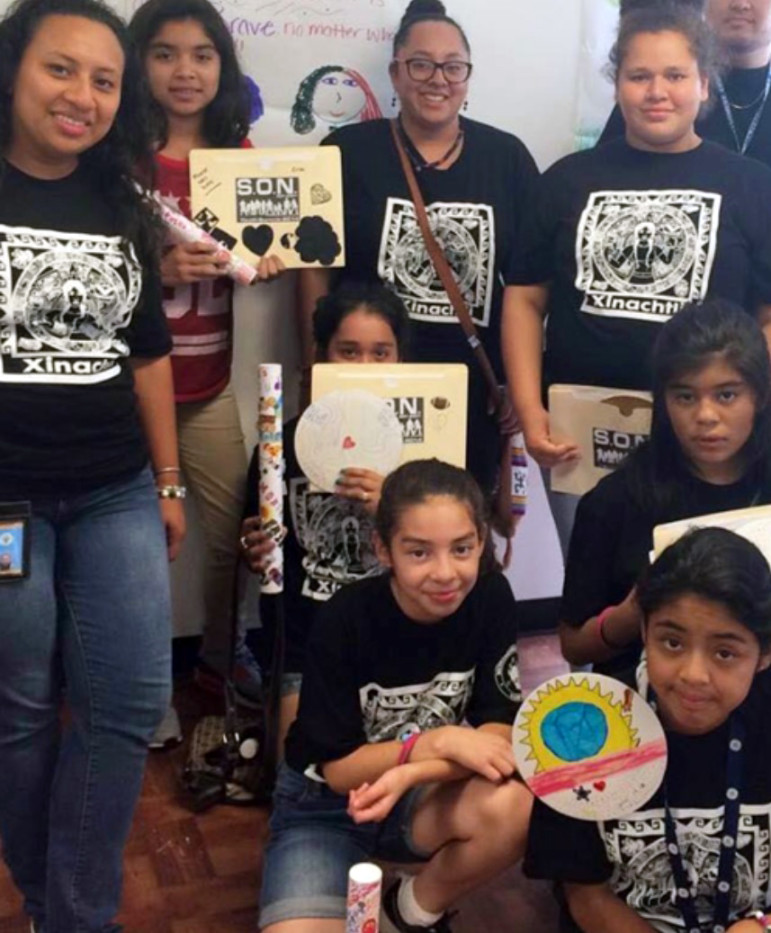
Girls who completed NOXTIN's Xinachtli program, a healing-based rites of passage curriculum for Latino girls.
Seven organizations will have a chance to further their efforts to help girls in the justice system thanks to more than $650,000 in funding from the National Girls Initiative.
The nonprofit alliances and organizations from across the country were recognized Wednesday by the initiative, a branch of the Office of Juvenile Justice and Delinquency Prevention, with its first Innovation Awards. The awards were granted to projects aimed at preventing arrest and detention, reforming policy and improving services for girls in the justice system.
The winners were:
- Alliance for Girls
- Connecticut Juvenile Justice Alliance
- Iowa Girls Justice Initiative
- Education Law Center
- NOXTIN and the National Compadres Network
- Pu’a Foundation
- Southwest Key Programs
The National Girls Initiative selected the winners from a pool of 77 candidates, seeking to recognize programs it felt would have the most impact in three priority areas identified by the OJJDP, said Jessie Domingo Salu, vice president of the National Crittenton Foundation, which operates the initiative with the American Institutes for Research. The money, which came from a mix of government and philanthropic funds, will be split among the seven winners based on their projects and budgets, Salu said.
[Related: Documentary Aims Spotlight on Broken Juvenile Justice System]
“These incredible projects show us that we can work together to reimagine our juvenile justice system, and that at every step, girls and their families should lead the way,” said Pamela Shifman, executive director of the NoVo Foundation, which helped support the awards, in a press release.
The number of girls arrested has increased over the last 20 years, even as the number of overall arrests has fallen. They represent a growing population in a juvenile justice system that advocates say is not suited to their needs and experiences. Studies have shown that girls are more likely to have been victims of sexual abuse and family violence, which can lead them to behaviors that land them in detention centers not designed to respond to their histories of trauma.
As a result, advocates and officials are calling for trauma-informed changes to both sentencing and detention designed to help girls rather than punish them.

Marcia Rincon-Gallardo
“We feel very humbled, very privileged to be able to receive this funding,” said Marcia Rincon-Gallardo, project director of NOXTIN, a think tank that promotes healing-based approaches, leadership development and health equity among Latino youth.
One of NOXTIN’s goals is to “build the next advocates” out of girls who are impacted by the juvenile justice system through its Xinachtli-Ollin Girls project, Rincon-Gallardo said. The project teaches girls healing-informed rites of passage and the history of Latino youth in the justice system. Girls will also do a research project about probation in Monterey County, California.
“We just want to uplift these girls and their voices, and so we're just sort of facilitating this process, so we're very, very happy,” she said.

Emma Mayerson
Emma Mayerson, director of the Alliance for Girls, an association of girl-serving programs in the San Francisco Bay Area, said the organization plans to use the funding to help provide greater access to community-coordinated programs for girls who might otherwise end up in the juvenile justice system.
“Girls’ needs are unrecognized by our system and continue to go unmet,” Mayerson said. Without a strong network of nonprofit and community-based organizations to meet girls’ needs, she said, girls are acting out to get someone’s attention and ending up in the juvenile justice system.
“What this grant is really helping us do is bring that community-coordinated approach to the public education system,” where the needs of girls can best be met, Mayerson said. “When the only supports we have are criminal justice-related, we've really failed before we've even started.”
More related articles:
Juvenile Defense Attorneys Badly Need Specialized Training, Higher Fees
What Science, Common Sense Tell Us About Kids and the Law
U.S. Should Adhere to Global Standards in How We Treat Our Youth
